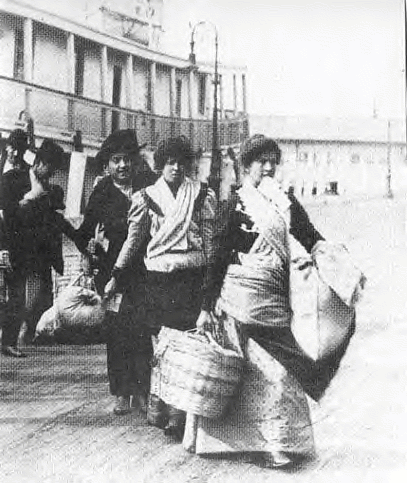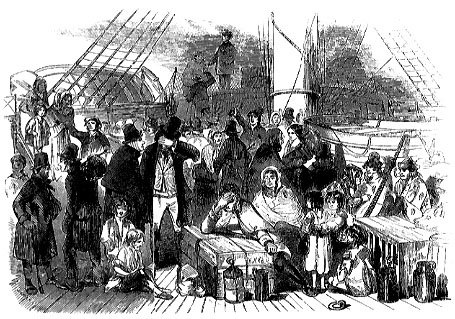Immigration has occurred from the beginning of time, and is still very popular for many countries across the world. In some cases, whole families would leave their home country, and migrate to a foreign one for a new and better life. Depending on one’s past and generation, immigration has proven to be a unique experience. For the most part however, immigrating was not something that people were happy to do. It involved a lot of work, money, persistence, and possibly even a crisis to occur.
This was the case for people leaving Ireland in the 1840s. “People of Ireland relied heavily on the success of the crops, and from 1845-1849 the potato crop failed year after year.
Almost half of the population of Ireland relied on the potato for their diet and income and with the devastation of failure of the crops the famine occurred.”[1] People were struggling to survive, specifically the lower class, and had no choice but to leave Ireland.
Vast numbers migrated from Ireland, and the majority went to North America. Canada alone had over 300,000 Irish people migrate in a five-year period. With the influx of immigrants, Canada’s population significantly increased, and Canada grew as a nation.
By the 1840s Canada had a population of about two million and with a large number of immigrants coming in, Canada was growing, changing and uniting. Although the Irish helped Canada positively, they also brought with them many difficulties and diseases.
The ships that many of the immigrants came over on had such terrible conditions that disease broke out. They were known by many as the “coffin ships”. The cholera epidemics killed endless numbers of people and truly affected Canada. Along with the difficult trip over, the early years of living in Canada did not get much better for them. The Irish went through a lot of discrimination, and difficulties years after they migrated.
The Irish famine immigration in the 1840s significantly affected Canada’s history in that it helped Canada grow, hit them with their first epidemic, and saw the impact of discrimination.
With the great numbers of immigrants coming into Canada, the country grew as a whole, both economically and socially. As stated previously, “the Irish came by the thousands before and after the great famines in Ireland. From 1845-1850, over 300,000 immigrants came to Canada.”[2]
In five years Canada’s population increased by fifteen percent since Canada was at around two million in the 1840s. This was a huge change for this young nation. The large increase, though at first extremely difficult, significantly benefited Canada. The provinces and colonies were doing well, but with the vast open land, immigrants were needed to help Canada grow. More people were needed to help every aspect of Canada’s growth.
A real boom in population is a great first step forward towards change. With all the new people coming in jobs opportunities were roaring in almost every area of business. “Sailors had to transport the immigrants, farmers fed them, and Canadian steamboats were paid to carry them and so on. Economically, Canada also grew.
New immigrants led to the expansion of the labour force, with in industries such as lumber, transport, farming and the grand trunk railway”[3] At first, many citizens of Canada were sceptical of all of the new comers, but people later understood their impact and importance.
At this point in Canada’s development there were five colonies, and Canada had not undergone confederation. Confederation occurred in 1867, and although there were many more causes that had larger impacts, the mass immigration helped everything along. Many feel somewhat doubtful of the impact of the immigration of Irish, but they truly helped Canada grow and unite.
Although the Irish immigrants were very beneficial to Canada, they also brought hardship and disease. Though new immigrants were exactly what Canada needed to develop, for such a young country it was extremely difficult for them to accommodate such immense numbers in a short period of time.
This quote exemplifies the feelings of numerous Canadians, “No other end than relieving the South of Ireland of a burden which [was] thrown upon the industrious classes of this young country.”[4] At this time Canada was still mothered by Britain and highly relied on her.
Since the five colonies were still starting up and not fully established, it was very tough for them to provide and help the Irish. Therefore it was a difficult burden for Canada to bear. Along with the troubles once arriving in Canada, the trip over was no different. Since it was the poorest people coming over, they did not have any money to spend on nice accommodations.
The conditions on the ships were unbearable, with extremely crammed rooms, beds for whole families, brown drinking water, and buckets for toilets. With the terrible conditions, it was no wonder that the epidemic arrived. “Cholera first reached Canada in 1832, brought by immigrants from Britain. Epidemics occurred in 1832, 1834, 1849, 1851, 1852, and 1854. The epidemics killed at least 20 000 people in Canada.”[5] Up to this point, Canada had not gone through any disease to this degree. Not only did this young country have to deal with the influx of immigrants, but also foreign diseases.
This disease turned into an epidemic because of how fast the disease was spreading and no one knew how to treat it. It was later discovered that cholera was acquired through drinking contaminated water, and since the ship environments were so deadly, many of the passengers got the disease and it eventually spread. “A main point of entry for the immigrants was in Quebec, and with the epidemic expanding a quarantine station was established at Grosse Ile in 1832.
The ill were either gathered or buried in shallow graves. The early years of Gross Ile were heartbreaking and horrific.”[6] This was Canada’s attempt to control the outbreak, and although it truly was horrific, the quarantine helped. It operated for more than a hundred years. The large amounts of immigrants were not all beneficial and gave Canada many problems to solve.
The Irish immigrants were faced with difficulty after difficulty once they finally arrived in Canada, and discrimination was one of the hardships. Not only were they migrating from a different country, but an entirely different world. The majority of people living in Canada were protestants from England, followed by the French Catholics.
There has often been conflict between the French and English, and at this time in Canada the British immigrants made up a lot of the population. With all of the Irish coming in, they started at the very bottom of the social ladder and had to work their way up. Depending on the time period, different cultures were at the bottom, and were discriminated against. In the 1840s and 1850s, it was the Irish who had it the worst. In some parts of Canada, the Irishmen were used as scapegoats, and got blamed for everyone else’s problems.
Whether people were unemployed, communities were overpopulated, the Irish were blamed. An example of this prejudice was written anonymously in Montreal by Gaslight. They said, “… and adjoining the Lachine Canal, stands a row of tenement houses. To a passerby, their neat and clean appearance would attract attention in so squalid and poor a district… What secret is hidden behind those brick walls? Eleven human beings eat, drink, sleep and perhaps wash in these three rooms.
In a Christian city is this right?”[7] This quote exemplifies the arrogance and judgment towards the immigrants. Since it occurred in Montreal, the Catholic aspect of discrimination was not as bad. This quote also shows that it was different people discriminating, and not just the average English person living in Canada. Another case of discrimination took place concerning jobs.
With the great number of people coming in, jobs were booming, and many large-scale projects in Canada were completed. “Jobs were plentiful in what was Canada’s first industrial area, spurred on by the construction of the nearby Lachine Canal, the Grand Trunk Railway, and the Victoria Bridge. But working conditions were grim: 15-hour days of back-breaking labor for a meager wage.”[8] It is illustrated here that they were faced with difficulties in different aspects of their life.
It was not only social discrimination but economic as well. Discrimination is very destructive to any community, and Canada suffered because of it. It puts endless limits on things and can destroy communities and morale. Different generations discriminate different cultures, and during the potato famine, the people of Ireland were the targets.
The influx of Irish immigrants in the 1840s significantly affected Canada both positively and negatively, and will always be an important part of Canada’s history. Before the mass immigration, Canada was not yet a country, but five colonies. All of the immigrants helped Canada grow together and truly become a nation.
The Irish helped the expansion of the labor force and many other things. Although they were very beneficial, many problems occurred after their arrival. Canada had their first epidemic with cholera, and over 20,000 people died because of it. Gross Ile, Canada’s first quarantine played an important role in controlling the epidemic.
The mood of many Canadians and the discrimination towards the Irish were also very significant. The journey over to Canada was terrible enough for the immigrants, and dealing with discrimination once they made it over was beyond awful. It caused numerous problems and made everything that much more difficult.
Immigration is tough on everyone, and a crisis does not need to occur in one’s homeland for them to make the trip. Canada is quite a multicultural country, and immigration from all countries will always be an important part of her history. It makes Canada unique and gives Canada her own separate and special identity.
Works Cited
Bilson, Geoffrey. “Cholera.” The Canadian Encyclopaedia. The Canadian Encyclopaedia, 2011. Web. 26 May 2011. <http://www.thecanadianencyclopedia.com/index.cfm?PgNm=TCE>.
Brune, Nick. Defining Canada: History, Identity, and Culture. Toronto: McGraw-Hill Ryerson, 2003. 120. Print.
Doyle, Driedger Sharon. An Irish Heart: How a Small Immigrant Community Shaped Canada. Toronto: HarperCollins, 2010. 122. Print
.Driedger, Sharon Doyle. “THE PLUCK OF THE IRISH. (cover story).” Maclean’s 116.11 (2003): 36. Canadian Reference Centre. EBSCO. Web. 26 May 2011.
Ferguson, Will. Canadian History for Dummies. Mississauga, Ont.: Wiley, 2007. 190. Print
“Irish Potato Famine.” Encyclopaedia Britannica. Encyclopaedia Britannica Online School Edition.
Encyclopaedia Britannica, 2011. Web. 23 May 2011.
<http://www.school.eb.com/eb/article-9003032>.
J.M. Bumsted, The Peoples of Canada: A Pre Confederation History, (Toronto: Oxford University Press, 1992) p.190
Synaxiom Media Group. “Economic Impact.” Following the Famine. Synaxiom Media Group, 2011. Web. 26 May 2011. <http://irishfamine.ca/canada/economic-impact>.
[1] Irish Potato Famine.” Encyclopaedia Britannica. Encyclopaedia Britannica
[2] Brune, Nick. Defining Canada: History, Identity, and Culture
[3] Synaxiom Media Group. “Economic Impact.” Following the Famine
[4] J.M. Bumsted, The Peoples of Canada: A Pre Confederation History,
[5] Bilson, Geoffrey. “Cholera.” The Canadian Encyclopaedia
[6] Ferguson, Will. Canadian History for Dummies. Mississauga
[7] Driedger Sharon. An Irish Heart: How a Small Immigrant Community Shaped Canada
[8] , Sharon Doyle. “THE PLUCK OF THE IRISH. (cover story).” Maclean’s



What were some negative consequences of Irish Immigration to Canada?
what challenges did the Irish experience
in canada?
WOW! Great! Really useful!